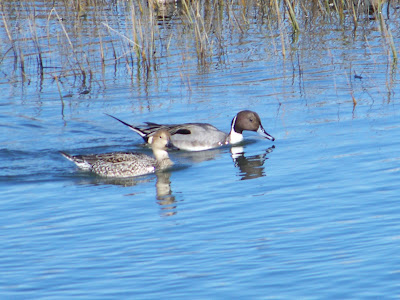.JPG) Northern Pintails at Newport Back Bay
Northern Pintails at Newport Back BayNorthern Pintails are the Audrey Hepburn of duckdom. They have long necks and a graceful bearing. They are much more slender than the Mallard. They are not as common in parks as Mallards and American Wigeons. They are more a of a wild bird. Nothern Pintails are not endangered, but they are declining. They breed in the Alaska and in the grasslands of Northern America. Like other birds who breed in these areas, they are facing loss of habitat.

Northern Pintail male at Newport Back Bay
The Northern Pintail seems deceptively easy to ID. However, if you only know it from the picture in the guide book, it is easy to overlook. The Northern Pintail's white neck stripe can appear very different depending on how it is swimming, standing or flying. Sometimes you can't see it at from your viewpoint, so if you depend on the white neck-stripe alone, you will miss it often in the field.

In the Wintersburg Channel at Bolsa Chica Ecological Reserve. Above and below.

Preening.

Swimming through the wetlands at Newport Back Bay
Field Marks to Look for:
- Long, graceful neck
- Long, pointy tail
- White chest
- Dark Bill
- Chocolate colored head
- White line that goes up the side of the neck

Bottoms up.
A Northern Pintail is a dabbling duck, so sometimes all you see is a feathery tail sticking out of the water. This can go on for a long time as they come up quickly for air and go back down again. Note the long, pointy tail. They eat aquatic plants, crustaceans, snails, grain, insects, and lots more.

Sometimes you can't see the head or chest.
Get to know the Northern Pintail well, and you won't often miss it in a crowd of ducks.
 Sleeping Northern Pintail at Bolsa Chica Ecological Reserve.
Sleeping Northern Pintail at Bolsa Chica Ecological Reserve.When a Northern Pintail tucks its head back to go to sleep, the white line can look like the little peak on a meringue cookie. See above and below. If you can see the tail, that is another field mark to notice. If not, you see something like the Northern Pintails below.

On the left sleeping Avocets. On the rocks behind and to the right, sleeping Northern Pintails. Bolsa Chica Ecological Reserve.
 Northern Pintail by the footbridge at Bolsa Chica Ecological Reserve.
Northern Pintail by the footbridge at Bolsa Chica Ecological Reserve.From behind you see two stripes like the photo above.

Near the foot bridge at Bolsa Chica Ecological Reserve.
And sometimes, depending on the viewing angle, you may not see the white line on their neck at all.

Cruising down a channel through the wetlands at Newport Back Bay.
Get familiar with how a Northern Pintail looks from different angles. Get familiar with the way its tail looks and its silhouette.
Northern Pintail--Bolsa Chica from OC Birder Girl on Vimeo.
Northern Pintails are seen in marshes, estuaries, farmland, grasslands, wetlands, and inter-tidal marshes. So if you are birding in winter in one of those areas, look around. If you see a slender duck with a white chest, take a closer look, you might see a Northern Pintail.

Below is a video I took at Bolsa Chica Ecological Reserve by the footbridge.

Male Northern Pintail with Mallards at Central Park in Huntington Beach after the rain filled up the lakes. One of two there that day. I haven't seen them here before.
Links
All About Birds from Cornell: Northern Pintail
Good detailed information about the Northern Pintail. Range, behavior, habitat, diet, and more.
Animal Diversity Web from University of Michigan: Northern Pintail
Detailed page about the Northern Pintail from the excellent University of Michigan site.
Audubon Society: Birds in Decline: Northern Pintail
Article about the decline in numbers of the Norther Pintail.
Bird Web from the Seattle Audubon Society
Good article about the Northern Pintail in Washington State. Lots of good information.
USGS Discovery for Recovery: An International Pintail Recovery Inititative
Pintails are suffering from a decline in numbers. This group seeks to increase there numbers.
Photos
Courtesy US Fish and Wildlife Service (Dave Menke)
Courtesy US Fish and Wildlife Service
 Courtesy US Fish and Wildlife Service (Dave Menke)
Courtesy US Fish and Wildlife Service (Dave Menke)
Video
The Internet Bird Collection: Northern Pintail
Fifteen videos of male and female Pintail. The Internet Bird Collection is a wonderful site. Check it out.















No comments:
Post a Comment